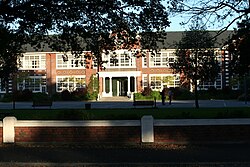| Hagley College Te Puna Wai O Waipapa | |
|---|---|
 Hagley College in 2008 | |
| Address | |
 | |
510 Hagley Avenue, Christchurch | |
| Coordinates | 43°32′16″S172°37′24″E / 43.5377°S 172.6234°E |
| Information | |
| Type | State co-ed Secondary (Years 9–15) |
| Established | 1966 |
| Ministry of Education Institution no. | 336 |
| Principal | Rowan Milburn |
| School roll | 2,248 [1] (March 2025) |
| Socio-economic decile | 6N [2] |
| Website | hagley.school.nz |
Hagley College (previously Hagley Community College and Hagley High School), is a state secondary school in inner-city Christchurch, New Zealand. Prior to 1966 the school was Christchurch West High School, which was founded in 1858.
